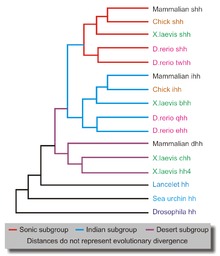Hedgehog pathway
| Parent |
| Cell surface receptor-related pathway |
| Subordinate |
| Partial routes active in dorsal / ventral neural tube patterning Ventral spinal column patterning Cartilage-chondrocyte development Lung development Prostate development |
| Gene Ontology |
|---|
| QuickGO |
The Hedgehog signaling pathway is a signal transduction pathway through which cells can respond to external signals. The signaling pathway is named after its ligand Hedgehog (Hh), a signal protein which, as a local morphogen, has an important function in the embryonic development of animals and which appeared very early in evolutionary history. A malfunction of this signal path leads to massive malformations in the course of embryonic development and can cause cancer in adults. Three hedgehog proteins are currently known in mammals ( sonic hedgehog , Indian hedgehog and desert hedgehog ).
functionality
The Hedgehog signaling pathway is based on proteolysis and is activated when the Hedgehog protein binds to the Patched (Ptch) receptor. As a result, another membrane-bound protein, Smoothened (Smo) , transmits a signal inside the cell that prevents the degradation of the regulatory protein Ci ( Cubitus interruptus ). This is broken down into a larger protein complex - consisting of the protein Costal , the serine-threonine kinase Fused (Fu) and the inhibitor of Fused - without the action of hedgehog . If Hedgehog is now active and transmits a signal, the protein Ci can no longer be broken down, diffuses into the cell nucleus and regulates gene expression there .
Occurrence
Hedgehog-like genes and two homologues to Patched have already been found in the nematode C. elegans , and it has been shown that these genes play an important role in the development of C. elegans , as in other animals .
In insects, the Hedgehog signaling pathway controls the correct sequence of segmentation and wing formation. In vertebrates, on the other hand, it induces the right-left asymmetry , regulates the liver metabolism, is particularly responsible for the development of non-alcoholic fatty liver and is responsible for the correct formation of the limbs.
discovery
The gene which codes for hedgehog in the fruit fly Drosophila melanogaster was among the first genes described as important for development. It was described for the first time by the researchers Christiane Nüsslein-Volhard and Eric F. Wieschaus (both received a Nobel Prize in 1995 “for their fundamental knowledge about the genetic control of early embryo development”), and through a genetic screen they discovered various mutations that affect embryonic development influenced by Drosophila. The name Hedgehog ( English for 'hedgehog') comes from the "hedgehog-like" appearance of fly larvae that carried a mutation in the gene for hedgehog.
inhibition
The inhibition of the Hedgehog signaling pathway is a novel therapeutic principle in the treatment of certain types of cancer such as basal cell carcinoma or medulloblastoma . In basal cell carcinomas and other solid tumors, there is often an abnormal activation of the Hedgehog signaling pathway, which is normally inactive in adults. The first representative of therapeutically used the new class of the Hedgehog signaling pathway inhibitors is vismodegib ( "first-in-class"), experimental drugs in clinical trials, for example, Sonidegib and Saridegib . They selectively inhibit the smoothened transmembrane receptor (SMO). At the beginning of August 2015, researchers from Göttingen demonstrated vitamin D3 ( calcitriol ) to be an effective inhibitor of this signaling pathway.
literature
- Bruce Alberts (Ed.): Molecular biology of the cell . 4th edition. Garland Science, New York 2002, ISBN 0-8153-3218-1 .
Web links
- Hedgehog Pathway Database ( Memento from March 23, 2010 in the Internet Archive ) (English)
Individual evidence
- ↑ a b Olivier Zugasti, Jeena Rajan, Patricia E. Kuwabara: The function and expansion of the Patched- and Hedgehog-related homologs in C. elegans . In: Genome Research . tape 15 , no. 10 , June 27, 2005, ISSN 1088-9051 , p. 1402-1410 , doi : 10.1101 / gr.3935405 , PMID 16204193 .
- ↑ Maria Novatchkova, Michael Wildpaner, Dieter Schweizer, Frank Eisenhaber: PhyloDome - visualization of taxonomic distributions of domains occurring in eukaryote protein sequence sets . In: Nucleic Acids Research . tape 33 , Web Server issue, July 1, 2005, ISSN 1362-4962 , p. W121-125 , doi : 10.1093 / nar / gki373 , PMID 15980439 .
- ↑ Madlen Matz-Soja, Christiane Rennert, Kristin Schönefeld, Susanne Aleithe, Jan Boettger, Wolfgang Schmidt-Heck, Thomas S. Weiss, Amalya Hovhannisyan, Sebastian Zellmer, Nora Klöting, Angela Schulz, Jürgen Kratzsch, Reinhard Guthke, Rolf Gebhardt: Hedgehog signaling is a potent regulator of liver lipid metabolism and reveals a GLI code associated with steatosis . In: eLife . 2016, p. e13308 , doi : 10.7554 / eLife.13308 , PMID 27185526 .
- ↑ 1995 Nobel Prize for the discovery of the genetic control of early embryonic development
- ↑ C. Nüsslein-Volhard, E. Wieschaus: Mutations affecting segment number and polarity in Drosophila . In: Nature . tape 287 , no. 5785 , October 30, 1980, ISSN 0028-0836 , p. 795-801 , PMID 6776413 .
- ↑ S. Grabbe et al .: New developments in the therapy of basal cell carcinoma. (PDF) (No longer available online.) In: Arzneimittelherapie 2013; 31. aerztekammer-bw.de, pp. 261–266 , archived from the original on December 24, 2013 ; Retrieved May 19, 2015 . Info: The archive link was inserted automatically and has not yet been checked. Please check the original and archive link according to the instructions and then remove this notice.
- ↑ Göttinger Tageblatt, "Researchers from Göttingen have discovered other functions of vitamin D3": Archive link ( Memento of the original from August 11, 2015 in the Internet Archive ) Info: The archive link was automatically inserted and not yet checked. Please check the original and archive link according to the instructions and then remove this notice.

